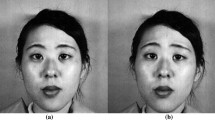Abstract
We propose a fuzzy rule-based system to map representations of the emotional state of an animated agent onto muscle contraction values for the appropriate facial expressions. Our implementation pays special attention to the way in which continuous changes in the intensity of emotions can be displayed smoothly on the graphical face. The rule system we have defined implements the patterns described by psychologists and researchers dealing with facial expressions of humans, including rules for displaying blends of expressions.
Preview
Unable to display preview. Download preview PDF.
Similar content being viewed by others
References
Bui, T.D (2001), Generation of facial expression from emotion using a Fuzzy Rule Based Sytem, Technical Report, Parlevink, Faculty of Computer Science, University of Twente.
Ekman, P. and W. Friesen(1975). Unmasking the Face. Prentice Hall.
Ekman, P., and W. Friesen, Facial Action Coding System. Consulting Psychologists Press, Inc., 1978.
Galernter, D.H. (1994), The muse in the machine. NewYork: Free Press.
Hayes-Roth, B. and R. van Gent(1997), Story-making with improvisational puppets, in Proceedings of 9th Conference Uncertainty in Artificial Intelligence, pp 122–127, San Francisco, Morgan Kaufmann.
J. Hendrix, Zs. Ruttkay, P. ten Hagen, H. Noot, A. Lelievre, B. de Ruiter (2000), A facial repertoire for avatars, Proceedings of theWorkshop “Interacting Agents”, Enschede, The Netherlands.
Izard, C.E. (1971), The face of emotion, NewYork: Appleton-Century-Crofts.
Izard, C.E. (1991), The psychology of emotions, NewYork: Plenum.
Izard, C.E. (1997), Emotions and facial expressions: A perspective from Differential Emotions Theory, in J.A. Russell and J.M. Fernandez-Dols (Eds.), The Psychology of Facial Expression, Maison des Sciences de l’Homme and Cambridge University Press.
Kesteren, A.J., R. Op den Akker, M. Poel and A. Nijholt (2000), Simulation of emotions of agents in virtual environments using neural networks. In: Learning to Behave: Internalising Knowledge. Proceeding TwenteWorkshops on Language technology 18 (TWLT18).
Lee, C.C. (1990), Fuzzy Logic in control systems: Fuzzy logic controller-parts i and ii. Fuzzy Sets and Systems 15:111–128,224-240
Nijholt, A., M. van den Berk and A. van Hessen (1998), A natural language web-based dialogue system with a talking face, Proceedings Text, Speech and Dialogue. Sojka et al (eds.), Brno, Czech republic, pp 415–420.
Nijholt, A., D. Heylen and R. Vertegaal (2000), Inhabited interfaces: Attentive conversational agents that help. In: Proceedings 3rd international Conference on Disability,Virtual Reality and Associated Technologies-CDVRAT2000, Alghero, Sardinia.
Paradiso, A. and M. L’Abbate (2001), A Model for the Generation and Combination of Emotional Expressions, In: Proceedings of theWorkshop on Multimodal Communication and Context in Embodied Agents. C. Pelachaud and I. Poggi (eds.)-Autonomous Agents, Montreal, Canada.
Parke, F.I. and Waters, K. (1994) Computer Facial Animation, AK Peters. ISBN 1-56881-014-8.
Perlin, K., and A. Goldberg (1996), Improv: A system for scripting interactive actors in virtual worlds, in SIGGRAPH’96, Proceedings of the 23rd Annual Conference on Computer Graphics, pp 205–216, NewYork, ACM Press.
Perlin, K. (1997), Layered compositing of facial expression, SIGGRAPH’97 Technical Sketch, NewYork University Media Research Lab. Available: <http://mrl.nyu.edu/improv/sig97-sketch/>.
F. Pighin, J. Hecker, D. Lischinski, R. Szeliski, and D. Salesin (1998), Synthesizing realistic facial expressions from photographs, in SIGGRAPH 98 Conference Proceedings, pages 75–84, ACM SIGGRAPH, July 1998.
Plutchik, R. (1962), The emotions: Facts, theories, and a new model, NewYork: Random House.
Prevost, S. and C. Pelachaud. (1995). Talking Heads: Physical, Linguistic and Cognitive Issues in Facial Animation. Course Notes for Computer Graphics International 1995, Leeds, UK
Russell, J.A. and J.M. Fernández-Dols (1997), The meaning of Faces, in J.A. Russell and J.M. Fernandez-Dols (Eds.), The Psychology of Facial Expression, Maison des Sciences de l’Homme and Cambridge University Press.
Stern, A., A. Frank, and B. Resner(1998), Virtual Petz:A hybrid approach to creating autonomous, lifelike Dogz and Catz, in Proceedings of the Second International Conference on Autonomous Agents, AGENTS98, pp 334–335, NewYork, ACM Press.
Author information
Authors and Affiliations
Editor information
Editors and Affiliations
Rights and permissions
Copyright information
© 2001 Springer-Verlag Berlin Heidelberg
About this paper
Cite this paper
Bui, T.D., Heylen, D., Poel, M., Nijholt, A. (2001). Generation of Facial Expressions from Emotion Using a Fuzzy Rule Based System. In: Stumptner, M., Corbett, D., Brooks, M. (eds) AI 2001: Advances in Artificial Intelligence. AI 2001. Lecture Notes in Computer Science(), vol 2256. Springer, Berlin, Heidelberg. https://doi.org/10.1007/3-540-45656-2_8
Download citation
DOI: https://doi.org/10.1007/3-540-45656-2_8
Published:
Publisher Name: Springer, Berlin, Heidelberg
Print ISBN: 978-3-540-42960-9
Online ISBN: 978-3-540-45656-8
eBook Packages: Springer Book Archive




